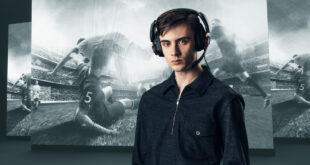Tearaway offers players a tactile paper world in which they help a little papercraft messenger buddy deliver the message trapped inside their envelope-shaped head, from the papery world of Tearaway into the real world.
Kenny Young, audio director and composer at Media Molecule, explains where this leftfield idea came from: “The kernel of the project was Rex Crowle, Tearaway’s creative director, considering how to make use of Vita’s unique rear touch pad and having the idea of one’s (virtual) fingers cleverly emerging into the gameworld from underneath the console.
"That spawned the idea of a tactile papercraft world you could poke and rip through. Then we built on all Vita’s other features – traditional gaming controls, front touch, gyros, accelerometer, front and rear cameras, and even the microphone – in ways that really integrated with the world and story.
“Early days on the project were pretty frustrating. Folks would moan it wasn’t sounding papery, and I’d bang the same drum: the game might look papery, but nothing behaves like paper. If nothing in the world moves, there’s no excuse to make it sound papery – things have to unroll or tear into existence, not just slide onto screen. You need papery behaviours to describe with sound, like unfolding or ripping to shreds. That’s why games with a papery schtick usually fail at pulling off the illusion: paper isn’t just a look or a sound that you can crowbar in.
“So when the game world started bending, flexing, folding, crumpling and tearing like paper, it became infinitely easier to back it up with sound; subtle stuff like the little sound a flap of paper makes when your messenger walks over it.
“But paper has a limited range of sonic possibilities, so you can’t afford to be slavishly literal the whole time. Conversely, if you ignore the papery requirement, you fail to support the illusion. Striking that balance and developing that language and aesthetic was a big focus. It was also an early aim to push the ambient soundscape and not have music everywhere. Giving the player a break from the intensity and purpose that music provides – thereby creating more impact the next time music appears – lets the world really speak for itself.”
FOLK STARS IN THE FOLD
That said, Tearaway does feature a great deal of acclaimed original music. And it’s not every day that folk music turns up in a game.
“Rex drew a lot from his Cornwall upbringing, so there’s heavy folk-culture influence,” explains Young. “Tearaway’s papery world is formed from stories – the notion of storytelling in an aural tradition has an analogue in folk music.
“My favourite music-writing collaboration moments on the project, working with composer Brian D’Oliveira, were when I’d create variations on a tune he’d written, and then he’d build on top of those. This idea of a tune changing over time, having different versions interpreted by different players and performed in different styles in different cultures is a phenomenon you can see in folk music; it resonates with the game’s encouragement for players to customise their experience in order to tell their own version of the story.
“There’s a naive quality to the game’s handmade papercraft aesthetic which finds a brilliant parallel in the handmade soundtrack. Folk music is the perfect fit. It doesn’t have to be slick, even though it often is these days. For me it’s about great tunes, dancing, honest emotions and stories about life.
“Embracing this approach opened the door to trying new things. We had a lot of fun playing instruments new to us. Brian even made some from paper – much of the percussion in his tracks is from paper contraptions he built. The soundtrack features a mad mix of unusual instruments: contra-alto clarinet, crumhorns, gemshorns, viols, gourde fiddle, hangdrum, bowed saw, pitched-up voice and a backwards violin.
“But this experimentation goes a lot further than us looking for an excuse to play with our toys. Tearaway takes the player on a journey, and music is a core part of that experience. The game starts out fairly folky, but over time it becomes deconstructed and surreal as the messenger gets closer towards their goal of leaving the paperworld and reaching the player in the real world.
“By the end, the music has gone completely analogue-electronic, passing through folk-infused, break-beat and dubstep, renaissance-hop and ambient mash-ups of earlier tracks. It’s quite a ride.”
To read more of Develop’s comprehensive Heard About audio profiles, visit our archive

 MCV/DEVELOP News, events, research and jobs from the games industry
MCV/DEVELOP News, events, research and jobs from the games industry


